Mapping Research Knowledge on Rice Husk Ash Application in Concrete: A Scientometric Review
Abstract
1. Introduction
2. Methods
3. Analysis of Results
3.1. Relevant Subject Areas and Yearly Publications
3.2. Sources of Publications
3.3. Keywords
3.4. Authors
3.5. Documents
3.6. Countries
4. Discussions and Future Perspectives
5. Conclusions
- An analysis of publication sources containing documents on RHA concrete research exposed that the topmost three sources are “Construction and building materials”, “IOP conference series: materials science and engineering”, and “Materials today: proceedings”, with 110, 48, and 45 papers, respectively, Also, the leading three publication sources in terms of overall citations are “Construction and building materials” with 6797, “Cement and concrete composites” with 2268, and “Journal of cleaner production” with 1579.
- A keyword analysis of the subject study field shows that the five most-often appearing keywords are rice husk ash, compressive strength, concretes, fly ash, and cements. The keyword analysis revealed that RHA had been studied primarily as a supplemental cementitious material (SCM) in concrete.
- Author analysis revealed that only 50 writers had published at least five publications on RHA concrete research. The top writers were classified according to their number of publications, citations, and average citations. Nuruddin M.F., with 16, Zain M.F.M., and Mahmud H.B., with 14 each, and Shafiq N., with 13 papers, are the top three authors in terms of overall publications. With 973 citations, Jaturapitakkul C. leads the field, followed by Zain M.F.M. with 738 and Chindaprasirt P. with 668 citations until 2021. In addition, when the average number of citations is compared, the following authors stand out: C. Jaturapitakkul has around 97, P. Chindaprasirt has approximately 84, and D.D. Bui has approximately 82 average citations.
- According to an analysis of papers providing data on RHA concrete, Ganesan K. [105] received 346 citations for their article “Rice husk ash blended cement: Assessment of optimal level of replacement for strength and permeability properties of concrete”. G.C. Isaia [106] and D.-Y. Yoo [107] received 329 and 228 citations, respectively, for their publications and were positioned in the best three. Moreover, only 18 publications acquired more than 200 citations in the subject area from 2011 to 2021.
- The leading nations were assessed based on their participation in RHA concrete research, and it was determined that only 27 countries published at least ten papers. India, Malaysia, and Thailand each delivered 293, 133, and 48 papers, respectively. In addition, these nations received the most citations, with Malaysia receiving 3104, India receiving 3098, and Thailand receiving 2049 citations.
- RHA has been investigated for its potential uses as SCM in conventional concrete, self-compacting concrete, and high-performance concrete because of the high silica concentration in its chemical composition. Furthermore, RHA is being investigated for application in the production of geopolymer concrete.
- The application of RHA in the construction sector will result in green construction by reducing cement demand and conserving natural sources when used as a substitute for cement and fine aggregate.
- The majority of the RHA applications are still under investigation, and further analysis is required before widening their effectiveness.
Supplementary Materials
Author Contributions
Funding
Institutional Review Board Statement
Informed Consent Statement
Data Availability Statement
Acknowledgments
Conflicts of Interest
References
- Eijgelaar, E.; Thaper, C.; Peeters, P. Antarctic cruise tourism: The paradoxes of ambassadorship, “last chance tourism” and greenhouse gas emissions. J. Sustain. Tour. 2010, 18, 337–354. [Google Scholar] [CrossRef]
- Yan, H.; Shen, Q.; Fan, L.C.H.; Wang, Y.; Zhang, L. Greenhouse gas emissions in building construction: A case study of One Peking in Hong Kong. Build. Environ. 2010, 45, 949–955. [Google Scholar] [CrossRef]
- Dimoudi, A.; Tompa, C. Energy and environmental indicators related to construction of office buildings. Resour. Conserv. Recycl. 2008, 53, 86–95. [Google Scholar] [CrossRef]
- Khan, M.; Cao, M.; Chaopeng, X.; Ali, M. Experimental and analytical study of hybrid fiber reinforced concrete prepared with basalt fiber under high temperature. Fire Mater. 2021, 46, 205–226. [Google Scholar] [CrossRef]
- Li, L.; Khan, M.; Bai, C.; Shi, K. Uniaxial Tensile Behavior, Flexural Properties, Empirical Calculation and Microstructure of Multi-Scale Fiber Reinforced Cement-Based Material at Elevated Temperature. Materials 2021, 14, 1827. [Google Scholar] [CrossRef]
- Zhou, S.; Xie, L.; Jia, Y.; Wang, C. Review of Cementitious Composites Containing Polyethylene Fibers as Repairing Materials. Polymers 2020, 12, 2624. [Google Scholar] [CrossRef]
- Khan, M.; Cao, M.; Xie, C.; Ali, M. Effectiveness of hybrid steel-basalt fiber reinforced concrete under compression. Case Stud. Constr. Mater. 2022, 16, e00941. [Google Scholar] [CrossRef]
- Khan, M.; Cao, M.; Ai, H.; Hussain, A. Basalt Fibers in Modified Whisker Reinforced Cementitious Composites. Period. Polytech. Civ. Eng. 2022. [Google Scholar] [CrossRef]
- Yuan, X.; Tian, Y.; Ahmad, W.; Ahmad, A.; Usanova, K.I.; Mohamed, A.M.; Khallaf, R. Machine Learning Prediction Models to Evaluate the Strength of Recycled Aggregate Concrete. Materials 2022, 15, 2823. [Google Scholar] [CrossRef]
- Ahmad, W.; Ahmad, A.; Ostrowski, K.A.; Aslam, F.; Joyklad, P.; Zajdel, P. Sustainable approach of using sugarcane bagasse ash in cement-based composites: A systematic review. Case Stud. Constr. Mater. 2021, 15, e00698. [Google Scholar] [CrossRef]
- Ahmad, A.; Farooq, F.; Niewiadomski, P.; Ostrowski, K.; Akbar, A.; Aslam, F.; Alyousef, R. Prediction of compressive strength of fly ash based concrete using individual and ensemble algorithm. Materials 2021, 14, 794. [Google Scholar] [CrossRef] [PubMed]
- Amran, M.; Fediuk, R.; Murali, G.; Avudaiappan, S.; Ozbakkaloglu, T.; Vatin, N.; Karelina, M.; Klyuev, S.; Gholampour, A. Fly Ash-Based Eco-Efficient Concretes: A Comprehensive Review of the Short-Term Properties. Materials 2021, 14, 4264. [Google Scholar] [CrossRef] [PubMed]
- Amran, M.; Murali, G.; Fediuk, R.; Vatin, N.; Vasilev, Y.; Abdelgader, H. Palm oil fuel ash-based eco-efficient concrete: A critical review of the short-term properties. Materials 2021, 14, 332. [Google Scholar] [CrossRef] [PubMed]
- Khan, M.I.; Abbas, Y.M.; Fares, G. Review of high and ultrahigh performance cementitious composites incorporating various combinations of fibers and ultrafines. J. King Saud Univ. -Eng. Sci. 2017, 29, 339–347. [Google Scholar] [CrossRef]
- Martuscelli, C.; Soares, C.; Camões, A.; Lima, N. Potential of fungi for concrete repair. Procedia Manuf. 2020, 46, 180–185. [Google Scholar] [CrossRef]
- Irshidat, M.R.; Al-Nuaimi, N. Industrial Waste Utilization of Carbon Dust in Sustainable Cementitious Composites Production. Materials 2020, 13, 3295. [Google Scholar] [CrossRef]
- Nafees, A.; Javed, M.F.; Khan, S.; Nazir, K.; Farooq, F.; Aslam, F.; Musarat, M.A.; Vatin, N.I. Predictive Modeling of Mechanical Properties of Silica Fume-Based Green Concrete Using Artificial Intelligence Approaches: MLPNN, ANFIS, and GEP. Materials 2021, 14, 7531. [Google Scholar] [CrossRef]
- Shahmansouri, A.A.; Bengar, H.A.; Ghanbari, S. Compressive strength prediction of eco-efficient GGBS-based geopolymer concrete using GEP method. J. Build. Eng. 2020, 31, 101326. [Google Scholar] [CrossRef]
- Miller, S.A. Supplementary cementitious materials to mitigate greenhouse gas emissions from concrete: Can there be too much of a good thing? J. Clean. Prod. 2018, 178, 587–598. [Google Scholar] [CrossRef]
- Habert, G.; Miller, S.A.; John, V.M.; Provis, J.L.; Favier, A.; Horvath, A.; Scrivener, K.L. Environmental impacts and decarbonization strategies in the cement and concrete industries. Nat. Rev. Earth Environ. 2020, 1, 559–573. [Google Scholar] [CrossRef]
- Di Filippo, J.; Karpman, J.; DeShazo, J.R. The impacts of policies to reduce CO2 emissions within the concrete supply chain. Cem. Concr. Compos. 2019, 101, 67–82. [Google Scholar] [CrossRef]
- Lee, C.T.; Hashim, H.; Ho, C.S.; Van Fan, Y.; Klemeš, J.J. Sustaining the low-carbon emission development in Asia and beyond: Sustainable energy, water, transportation and low-carbon emission technology. J. Clean. Prod. 2017, 146, 1–13. [Google Scholar] [CrossRef]
- Li, X.; Qin, D.; Hu, Y.; Ahmad, W.; Ahmad, A.; Aslam, F.; Joyklad, P. A systematic review of waste materials in cement-based composites for construction applications. J. Build. Eng. 2021, 45, 103447. [Google Scholar] [CrossRef]
- Zhang, B.; Ahmad, W.; Ahmad, A.; Aslam, F.; Joyklad, P. A scientometric analysis approach to analyze the present research on recycled aggregate concrete. J. Build. Eng. 2021, 46, 103679. [Google Scholar] [CrossRef]
- Alyousef, R.; Ahmad, W.; Ahmad, A.; Aslam, F.; Joyklad, P.; Alabduljabbar, H. Potential use of recycled plastic and rubber aggregate in cementitious materials for sustainable construction: A review. J. Clean. Prod. 2021, 329, 129736. [Google Scholar] [CrossRef]
- El-Kassas, A.M.; Elsheikh, A.H. A new eco-friendly mechanical technique for production of rice straw fibers for medium density fiberboards manufacturing. Int. J. Environ. Sci. Technol. 2021, 18, 979–988. [Google Scholar] [CrossRef]
- Elsheikh, A.H.; Panchal, H.; Shanmugan, S.; Muthuramalingam, T.; El-Kassas, A.M.; Ramesh, B. Recent progresses in wood-plastic composites: Pre-processing treatments, manufacturing techniques, recyclability and eco-friendly assessment. Clean. Eng. Technol. 2022, 8, 100450. [Google Scholar] [CrossRef]
- Mikulčić, H.; Klemeš, J.J.; Vujanović, M.; Urbaniec, K.; Duić, N. Reducing greenhouse gasses emissions by fostering the deployment of alternative raw materials and energy sources in the cleaner cement manufacturing process. J. Clean. Prod. 2016, 136, 119–132. [Google Scholar] [CrossRef]
- Khan, M.; Ali, M. Improvement in concrete behavior with fly ash, silica-fume and coconut fibres. Constr. Build. Mater. 2019, 203, 174–187. [Google Scholar] [CrossRef]
- Khan, M.; Cao, M.; Hussain, A.; Chu, S.H. Effect of silica-fume content on performance of CaCO3 whisker and basalt fiber at matrix interface in cement-based composites. Constr. Build. Mater. 2021, 300, 124046. [Google Scholar] [CrossRef]
- Khan, M.; Rehman, A.; Ali, M. Efficiency of silica-fume content in plain and natural fiber reinforced concrete for concrete road. Constr. Build. Mater. 2020, 244, 118382. [Google Scholar] [CrossRef]
- Park, S.; Wu, S.; Liu, Z.; Pyo, S. The role of supplementary cementitious materials (SCMs) in ultra high performance concrete (UHPC): A review. Materials 2021, 14, 1472. [Google Scholar] [CrossRef] [PubMed]
- Xu, Q.; Ji, T.; Gao, S.-J.; Yang, Z.; Wu, N. Characteristics and applications of sugar cane bagasse ash waste in cementitious materials. Materials 2019, 12, 39. [Google Scholar] [CrossRef] [PubMed]
- Supino, S.; Malandrino, O.; Testa, M.; Sica, D. Sustainability in the EU cement industry: The Italian and German experiences. J. Clean. Prod. 2016, 112, 430–442. [Google Scholar] [CrossRef]
- Juenger, M.C.G.; Snellings, R.; Bernal, S.A. Supplementary cementitious materials: New sources, characterization, and performance insights. Cem. Concr. Res. 2019, 122, 257–273. [Google Scholar] [CrossRef]
- Lothenbach, B.; Scrivener, K.; Hooton, R.D. Supplementary cementitious materials. Cem. Concr. Res. 2011, 41, 1244–1256. [Google Scholar] [CrossRef]
- Shanmugasundaram, N.; Praveenkumar, S. Influence of supplementary cementitious materials, curing conditions and mixing ratios on fresh and mechanical properties of engineered cementitious composites—A review. Constr. Build. Mater. 2021, 309, 125038. [Google Scholar] [CrossRef]
- Shi, C.; Qu, B.; Provis, J.L. Recent progress in low-carbon binders. Cem. Concr. Res. 2019, 122, 227–250. [Google Scholar] [CrossRef]
- Zheng, Y.; Wang, C.; Zhou, S.; Luo, C. The self-gelation properties of calcined wollastonite powder. Constr. Build. Mater. 2021, 290, 123061. [Google Scholar] [CrossRef]
- Ahmad, W.; Ahmad, A.; Ostrowski, K.A.; Aslam, F.; Joyklad, P. A scientometric review of waste material utilization in concrete for sustainable construction. Case Stud. Constr. Mater. 2021, 15, e00683. [Google Scholar] [CrossRef]
- Tam, V.W.Y.; Tam, C.M. A review on the viable technology for construction waste recycling. Resour. Conserv. Recycl. 2006, 47, 209–221. [Google Scholar] [CrossRef]
- Tang, P.; Chen, W.; Xuan, D.; Zuo, Y.; Poon, C.S. Investigation of cementitious properties of different constituents in municipal solid waste incineration bottom ash as supplementary cementitious materials. J. Clean. Prod. 2020, 258, 120675. [Google Scholar] [CrossRef]
- He, Z.-H.; Zhu, H.-N.; Zhang, M.-Y.; Shi, J.-Y.; Du, S.-G.; Liu, B. Autogenous shrinkage and nano-mechanical properties of UHPC containing waste brick powder derived from construction and demolition waste. Constr. Build. Mater. 2021, 306, 124869. [Google Scholar] [CrossRef]
- Shi, J.; Liu, B.; He, Z.; Liu, Y.; Jiang, J.; Xiong, T.; Shi, J. A green ultra-lightweight chemically foamed concrete for building exterior: A feasibility study. J. Clean. Prod. 2021, 288, 125085. [Google Scholar] [CrossRef]
- Aprianti, E. A huge number of artificial waste material can be supplementary cementitious material (SCM) for concrete production–a review part II. J. Clean. Prod. 2017, 142, 4178–4194. [Google Scholar] [CrossRef]
- Sohal, K.S.; Singh, R. Sustainable Use of Sugarcane Bagasse Ash in Concrete Production; Springer: Singapore, 2021; pp. 397–407. [Google Scholar]
- Abdulkadir, T.S.; Oyejobi, D.O.; Lawal, A.A. Evaluation of sugarcane bagasse ash as a replacement for cement in concrete works. Acta Tech. Corviniensis-Bull. Eng. 2014, 7, 71. [Google Scholar]
- Ahmed, A.; Hyndman, F.; Kamau, J.; Fitriani, H. Rice Husk Ash as a Cement Replacement in High Strength Sustainable Concrete; Trans Tech Publications Ltd.: Bäch, Switzerland, 2020; pp. 90–98. [Google Scholar]
- Zareei, S.A.; Ameri, F.; Dorostkar, F.; Ahmadi, M. Rice husk ash as a partial replacement of cement in high strength concrete containing micro silica: Evaluating durability and mechanical properties. Case Stud. Constr. Mater. 2017, 7, 73–81. [Google Scholar] [CrossRef]
- Ihedioha, J.N.; Ukoha, P.O.; Ekere, N.R. Ecological and human health risk assessment of heavy metal contamination in soil of a municipal solid waste dump in Uyo, Nigeria. Environ. Geochem. Health 2017, 39, 497–515. [Google Scholar] [CrossRef]
- Iftikhar, B.; Alih, S.C.; Vafaei, M.; Elkotb, M.A.; Shutaywi, M.; Javed, M.F.; Deebani, W.; Khan, M.I.; Aslam, F. Predictive modeling of compressive strength of sustainable rice husk ash concrete: Ensemble learner optimization and comparison. J. Clean. Prod. 2022, 348, 131285. [Google Scholar] [CrossRef]
- Prasara-A, J.; Gheewala, S.H. Sustainable utilization of rice husk ash from power plants: A review. J. Clean. Prod. 2017, 167, 1020–1028. [Google Scholar] [CrossRef]
- De Sensale, G.R. Strength development of concrete with rice-husk ash. Cem. Concr. Compos. 2006, 28, 158–160. [Google Scholar] [CrossRef]
- He, Z.-H.; Yang, Y.; Yuan, Q.; Shi, J.-Y.; Liu, B.-J.; Liang, C.-F.; Du, S.-G. Recycling hazardous water treatment sludge in cement-based construction materials: Mechanical properties, drying shrinkage, and nano-scale characteristics. J. Clean. Prod. 2021, 290, 125832. [Google Scholar] [CrossRef]
- Sandhu, R.K.; Siddique, R. Influence of rice husk ash (RHA) on the properties of self-compacting concrete: A review. Constr. Build. Mater. 2017, 153, 751–764. [Google Scholar] [CrossRef]
- Siddika, A.; Mamun, M.; Al, A.; Ali, M. Study on concrete with rice husk ash. Innov. Infrastruct. Solut. 2018, 3, 18. [Google Scholar] [CrossRef]
- Hwang, C.-L.; Huynh, T.-P. Effect of alkali-activator and rice husk ash content on strength development of fly ash and residual rice husk ash-based geopolymers. Constr. Build. Mater. 2015, 101, 1–9. [Google Scholar] [CrossRef]
- Koushkbaghi, M.; Kazemi, M.J.; Mosavi, H.; Mohseni, E. Acid resistance and durability properties of steel fiber-reinforced concrete incorporating rice husk ash and recycled aggregate. Constr. Build. Mater. 2019, 202, 266–275. [Google Scholar] [CrossRef]
- Subashi De Silva, G.; Priyamali, M.W.S. Potential use of waste rice husk ash for concrete paving blocks: Strength, durability, and run-off properties. Int. J. Pavement Eng. 2020, 21, 1–13. [Google Scholar] [CrossRef]
- Sutas, J.; Mana, A.; Pitak, L. Effect of rice husk and rice husk ash to properties of bricks. Procedia Eng. 2012, 32, 1061–1067. [Google Scholar] [CrossRef]
- Kanimozhi, K.; Prabunathan, P.; Selvaraj, V.; Alagar, M. Vinyl silane-functionalized rice husk ash-reinforced unsaturated polyester nanocomposites. RSC Adv. 2014, 4, 18157–18163. [Google Scholar] [CrossRef]
- Elahi, M.M.A.; Shearer, C.R.; Reza, A.N.R.; Saha, A.K.; Khan, M.N.N.; Hossain, M.M.; Sarker, P.K. Improving the sulfate attack resistance of concrete by using supplementary cementitious materials (SCMs): A review. Constr. Build. Mater. 2021, 281, 122628. [Google Scholar] [CrossRef]
- El-Sayed, M.A.; El-Samni, T.M. Physical and chemical properties of rice straw ash and its effect on the cement paste produced from different cement types. J. King Saud Univ. -Eng. Sci. 2006, 19, 21–29. [Google Scholar] [CrossRef]
- Meddah, M.S.; Praveenkumar, T.R.; Vijayalakshmi, M.M.; Manigandan, S.; Arunachalam, R. Mechanical and microstructural characterization of rice husk ash and Al2O3 nanoparticles modified cement concrete. Constr. Build. Mater. 2020, 255, 119358. [Google Scholar] [CrossRef]
- Channa, S.H.; Mangi, S.A.; Bheel, N.; Soomro, F.A.; Khahro, S.H. Short-term analysis on the combined use of sugarcane bagasse ash and rice husk ash as supplementary cementitious material in concrete production. Environ. Sci. Pollut. Res. 2022, 29, 3555–3564. [Google Scholar] [CrossRef] [PubMed]
- Bonfim, W.B.; de Paula, H.M. Characterization of different biomass ashes as supplementary cementitious material to produce coating mortar. J. Clean. Prod. 2021, 291, 125869. [Google Scholar] [CrossRef]
- Khan, K.; Ullah, M.F.; Shahzada, K.; Amin, M.N.; Bibi, T.; Wahab, N.; Aljaafari, A. Effective use of micro-silica extracted from rice husk ash for the production of high-performance and sustainable cement mortar. Constr. Build. Mater. 2020, 258, 119589. [Google Scholar] [CrossRef]
- De Sensale, G.R. Effect of rice-husk ash on durability of cementitious materials. Cem. Concr. Compos. 2010, 32, 718–725. [Google Scholar] [CrossRef]
- Sujivorakul, C.; Jaturapitakkul, C.; Taotip, A. Utilization of fly ash, rice husk ash, and palm oil fuel ash in glass fiber–reinforced concrete. J. Mater. Civ. Eng. 2011, 23, 1281–1288. [Google Scholar] [CrossRef]
- Amin, M.N.; Hissan, S.; Shahzada, K.; Khan, K.; Bibi, T. Pozzolanic reactivity and the influence of rice husk ash on early-age autogenous shrinkage of concrete. Front. Mater. 2019, 6, 150. [Google Scholar] [CrossRef]
- Siddika, A.; Mamun, M.A.A.; Alyousef, R.; Mohammadhosseini, H. State-of-the-art-review on rice husk ash: A supplementary cementitious material in concrete. J. King Saud Univ. -Eng. Sci. 2021, 33, 294–307. [Google Scholar] [CrossRef]
- Fernandes, I.J.; Calheiro, D.; Kieling, A.G.; Moraes, C.A.M.; Rocha, T.L.A.C.; Brehm, F.A.; Modolo, R.C.E. Characterization of rice husk ash produced using different biomass combustion techniques for energy. Fuel 2016, 165, 351–359. [Google Scholar] [CrossRef]
- Pode, R. Potential applications of rice husk ash waste from rice husk biomass power plant. Renew. Sustain. Energy Rev. 2016, 53, 1468–1485. [Google Scholar] [CrossRef]
- Goyal, S.K.; Jogdand, S.V.; Agrawal, A.K. Energy use pattern in rice milling industries—A critical appraisal. J. Food Sci. Technol. 2014, 51, 2907–2916. [Google Scholar] [CrossRef] [PubMed][Green Version]
- Rukzon, S.; Chindaprasirt, P. Use of disposed waste ash from landfills to replace Portland cement. Waste Manag. Res. 2009, 27, 588–594. [Google Scholar] [CrossRef] [PubMed]
- Alex, J.; Dhanalakshmi, J.; Ambedkar, B. Experimental investigation on rice husk ash as cement replacement on concrete production. Constr. Build. Mater. 2016, 127, 353–362. [Google Scholar] [CrossRef]
- Ahsan, M.B.; Hossain, Z. Supplemental use of rice husk ash (RHA) as a cementitious material in concrete industry. Constr. Build. Mater. 2018, 178, 1–9. [Google Scholar] [CrossRef]
- Jamil, M.; Kaish, A.; Raman, S.N.; Zain, M.F.M. Pozzolanic contribution of rice husk ash in cementitious system. Constr. Build. Mater. 2013, 47, 588–593. [Google Scholar] [CrossRef]
- Tran, V.-A.; Hwang, C.-L.; Vo, D.-H. Manufacture and Engineering Properties of Cementitious Mortar Incorporating Unground Rice Husk Ash as Fine Aggregate. J. Mater. Civ. Eng. 2021, 33, 04021258. [Google Scholar] [CrossRef]
- Bheel, N.; Meghwar, S.L.; Sohu, S.; Khoso, A.R.; Kumar, A.; Shaikh, Z.H. Experimental study on recycled concrete aggregates with rice husk ash as partial cement replacement. Civ. Eng. J. 2018, 4, 2305–2314. [Google Scholar] [CrossRef]
- Das, S.; Patra, R.K.; Mukharjee, B.B. Feasibility study of utilisation of ferrochrome slag as fine aggregate and rice husk ash as cement replacement for developing sustainable concrete. Innov. Infrastruct. Solut. 2021, 6, 1–18. [Google Scholar] [CrossRef]
- Ramasamy, V.-W. Compressive strength and durability properties of rice husk ash concrete. KSCE J. Civ. Eng. 2012, 16, 93–102. [Google Scholar] [CrossRef]
- Limbachiya, M.; Meddah, M.S.; Ouchagour, Y. Use of recycled concrete aggregate in fly-ash concrete. Constr. Build. Mater. 2012, 27, 439–449. [Google Scholar] [CrossRef]
- Zakka, W.P.; Lim, N.H.A.S.; Khun, M.C. A scientometric review of geopolymer concrete. J. Clean. Prod. 2021, 280, 124353. [Google Scholar] [CrossRef]
- Udomsap, A.D.; Hallinger, P. A bibliometric review of research on sustainable construction, 1994–2018. J. Clean. Prod. 2020, 254, 120073. [Google Scholar] [CrossRef]
- Yang, H.; Liu, L.; Yang, W.; Liu, H.; Ahmad, W.; Ahmad, A.; Aslam, F.; Joyklad, P. A comprehensive overview of geopolymer composites: A bibliometric analysis and literature review. Case Stud. Constr. Mater. 2022, 16, e00830. [Google Scholar] [CrossRef]
- Xu, Y.; Zeng, J.; Chen, W.; Jin, R.; Li, B.; Pan, Z. A holistic review of cement composites reinforced with graphene oxide. Constr. Build. Mater. 2018, 171, 291–302. [Google Scholar] [CrossRef]
- Xiao, X.; Skitmore, M.; Li, H.; Xia, B. Mapping knowledge in the economic areas of green building using scientometric analysis. Energies 2019, 12, 3011. [Google Scholar] [CrossRef]
- Darko, A.; Chan, A.P.; Huo, X.; Owusu-Manu, D.-G. A scientometric analysis and visualization of global green building research. Build. Environ. 2019, 149, 501–511. [Google Scholar] [CrossRef]
- Aghaei Chadegani, A.; Salehi, H.; Yunus, M.; Farhadi, H.; Fooladi, M.; Farhadi, M.; Ale Ebrahim, N. A comparison between two main academic literature collections: Web of Science and Scopus databases. Asian Soc. Sci. 2013, 9, 18–26. [Google Scholar] [CrossRef]
- Afgan, S.; Bing, C. Scientometric review of international research trends on thermal energy storage cement based composites via integration of phase change materials from 1993 to 2020. Constr. Build. Mater. 2021, 278, 122344. [Google Scholar] [CrossRef]
- Bergman, E.M.L. Finding citations to social work literature: The relative benefits of using Web of Science, Scopus, or Google Scholar. J. Acad. Librariansh. 2012, 38, 370–379. [Google Scholar] [CrossRef]
- Meho, L.I. Using Scopus’s CiteScore for assessing the quality of computer science conferences. J. Informetr. 2019, 13, 419–433. [Google Scholar] [CrossRef]
- Zuo, J.; Zhao, Z.-Y. Green building research–current status and future agenda: A review. Renew. Sustain. Energy Rev. 2014, 30, 271–281. [Google Scholar] [CrossRef]
- Darko, A.; Zhang, C.; Chan, A.P. Drivers for green building: A review of empirical studies. Habitat Int. 2017, 60, 34–49. [Google Scholar] [CrossRef]
- Ahmad, W.; Khan, M.; Smarzewski, P. Effect of Short Fiber Reinforcements on Fracture Performance of Cement-Based Materials: A Systematic Review Approach. Materials 2021, 14, 1745. [Google Scholar] [CrossRef]
- Markoulli, M.P.; Lee, C.I.; Byington, E.; Felps, W.A. Mapping Human Resource Management: Reviewing the field and charting future directions. Hum. Resour. Manag. Rev. 2017, 27, 367–396. [Google Scholar] [CrossRef]
- Jin, R.; Gao, S.; Cheshmehzangi, A.; Aboagye-Nimo, E. A holistic review of off-site construction literature published between 2008 and 2018. J. Clean. Prod. 2018, 202, 1202–1219. [Google Scholar] [CrossRef]
- Park, J.Y.; Nagy, Z. Comprehensive analysis of the relationship between thermal comfort and building control research-A data-driven literature review. Renew. Sustain. Energy Rev. 2018, 82, 2664–2679. [Google Scholar] [CrossRef]
- Oraee, M.; Hosseini, M.R.; Papadonikolaki, E.; Palliyaguru, R.; Arashpour, M. Collaboration in BIM-based construction networks: A bibliometric-qualitative literature review. Int. J. Proj. Manag. 2017, 35, 1288–1301. [Google Scholar] [CrossRef]
- Van Eck, N.J.; Waltman, L. Software survey: VOSviewer, a computer program for bibliometric mapping. Scientometrics 2010, 84, 523–538. [Google Scholar] [CrossRef]
- Wuni, I.Y.; Shen, G.Q.; Osei-Kyei, R. Scientometric review of global research trends on green buildings in construction journals from 1992 to 2018. Energy Build. 2019, 190, 69–85. [Google Scholar] [CrossRef]
- Su, H.-N.; Lee, P.-C. Mapping knowledge structure by keyword co-occurrence: A first look at journal papers in Technology Foresight. Scientometrics 2010, 85, 65–79. [Google Scholar] [CrossRef]
- Yu, F.; Hayes, B.E. Applying data analytics and visualization to assessing the research impact of the Cancer Cell Biology (CCB) Program at the University of North Carolina at Chapel Hill. J. eSci. Librariansh. 2018, 7, 4. [Google Scholar] [CrossRef]
- Ganesan, K.; Rajagopal, K.; Thangavel, K. Rice husk ash blended cement: Assessment of optimal level of replacement for strength and permeability properties of concrete. Constr. Build. Mater. 2008, 22, 1675–1683. [Google Scholar] [CrossRef]
- Isaia, G.C.; GastaldinI, A.L.G.; Moraes, R. Physical and pozzolanic action of mineral additions on the mechanical strength of high-performance concrete. Cem. Concr. Compos. 2003, 25, 69–76. [Google Scholar] [CrossRef]
- Yoo, D.-Y.; Banthia, N. Mechanical properties of ultra-high-performance fiber-reinforced concrete: A review. Cem. Concr. Compos. 2016, 73, 267–280. [Google Scholar] [CrossRef]
- Bui, D.D.; Hu, J.; Stroeven, P. Particle size effect on the strength of rice husk ash blended gap-graded Portland cement concrete. Cem. Concr. Compos. 2005, 27, 357–366. [Google Scholar] [CrossRef]
- Sata, V.; Jaturapitakkul, C.; Kiattikomol, K. Influence of pozzolan from various by-product materials on mechanical properties of high-strength concrete. Constr. Build. Mater. 2007, 21, 1589–1598. [Google Scholar] [CrossRef]
- Zhang, M.-H.; Malhotra, V.M. High-performance concrete incorporating rice husk ash as a supplementary cementing material. ACI Mater. J. 1996, 93, 629–636. [Google Scholar]
- Nehdi, M.; Duquette, J.; El Damatty, A. Performance of rice husk ash produced using a new technology as a mineral admixture in concrete. Cem. Concr. Res. 2003, 33, 1203–1210. [Google Scholar] [CrossRef]
- Paris, J.M.; Roessler, J.G.; Ferraro, C.C.; DeFord, H.D.; Townsend, T.G. A review of waste products utilized as supplements to Portland cement in concrete. J. Clean. Prod. 2016, 121, 1–18. [Google Scholar] [CrossRef]
- Wongpa, J.; Kiattikomol, K.; Jaturapitakkul, C.; Chindaprasirt, P. Compressive strength, modulus of elasticity, and water permeability of inorganic polymer concrete. Mater. Des. 2010, 31, 4748–4754. [Google Scholar] [CrossRef]
- Khan, M.N.N.; Jamil, M.; Karim, M.R.; Zain, M.F.M.; Kaish, A.A. Utilization of rice husk ash for sustainable construction: A review. Res. J. Appl. Sci. Eng. Technol. 2015, 9, 1119–1127. [Google Scholar] [CrossRef]
- Raisi, E.M.; Amiri, J.V.; Davoodi, M.R. Influence of rice husk ash on the fracture characteristics and brittleness of self-compacting concrete. Eng. Fract. Mech. 2018, 199, 595–608. [Google Scholar] [CrossRef]
- Thiedeitz, M.; Schmidt, W.; Härder, M.; Kränkel, T. Performance of rice husk ash as supplementary cementitious material after production in the field and in the lab. Materials 2020, 13, 4319. [Google Scholar] [CrossRef]
- Cordeiro, G.C.; Toledo Filho, R.D.; de Moraes Rego Fairbairn, E. Use of ultrafine rice husk ash with high-carbon content as pozzolan in high performance concrete. Mater. Struct. 2009, 42, 983–992. [Google Scholar] [CrossRef]
- Huang, H.; Gao, X.; Wang, H.; Ye, H. Influence of rice husk ash on strength and permeability of ultra-high performance concrete. Constr. Build. Mater. 2017, 149, 621–628. [Google Scholar] [CrossRef]
- Kaur, K.; Singh, J.; Kaur, M. Compressive strength of rice husk ash based geopolymer: The effect of alkaline activator. Constr. Build. Mater. 2018, 169, 188–192. [Google Scholar] [CrossRef]
- Pham, T.M. Enhanced properties of high-silica rice husk ash-based geopolymer paste by incorporating basalt fibers. Constr. Build. Mater. 2020, 245, 118422. [Google Scholar]
- Wen, N.; Zhao, Y.; Yu, Z.; Liu, M. A sludge and modified rice husk ash-based geopolymer: Synthesis and characterization analysis. J. Clean. Prod. 2019, 226, 805–814. [Google Scholar] [CrossRef]
- Alghamdi, H. A review of cementitious alternatives within the development of environmental sustainability associated with cement replacement. Environ. Sci. Pollut. Res. 2022, 29, 1–19. [Google Scholar] [CrossRef]
- Gustavsson, L.; Sathre, R. Variability in energy and carbon dioxide balances of wood and concrete building materials. Build. Environ. 2006, 41, 940–951. [Google Scholar] [CrossRef]
- Gursel, A.P.; Maryman, H.; Ostertag, C. A life-cycle approach to environmental, mechanical, and durability properties of “green” concrete mixes with rice husk ash. J. Clean. Prod. 2016, 112, 823–836. [Google Scholar] [CrossRef]
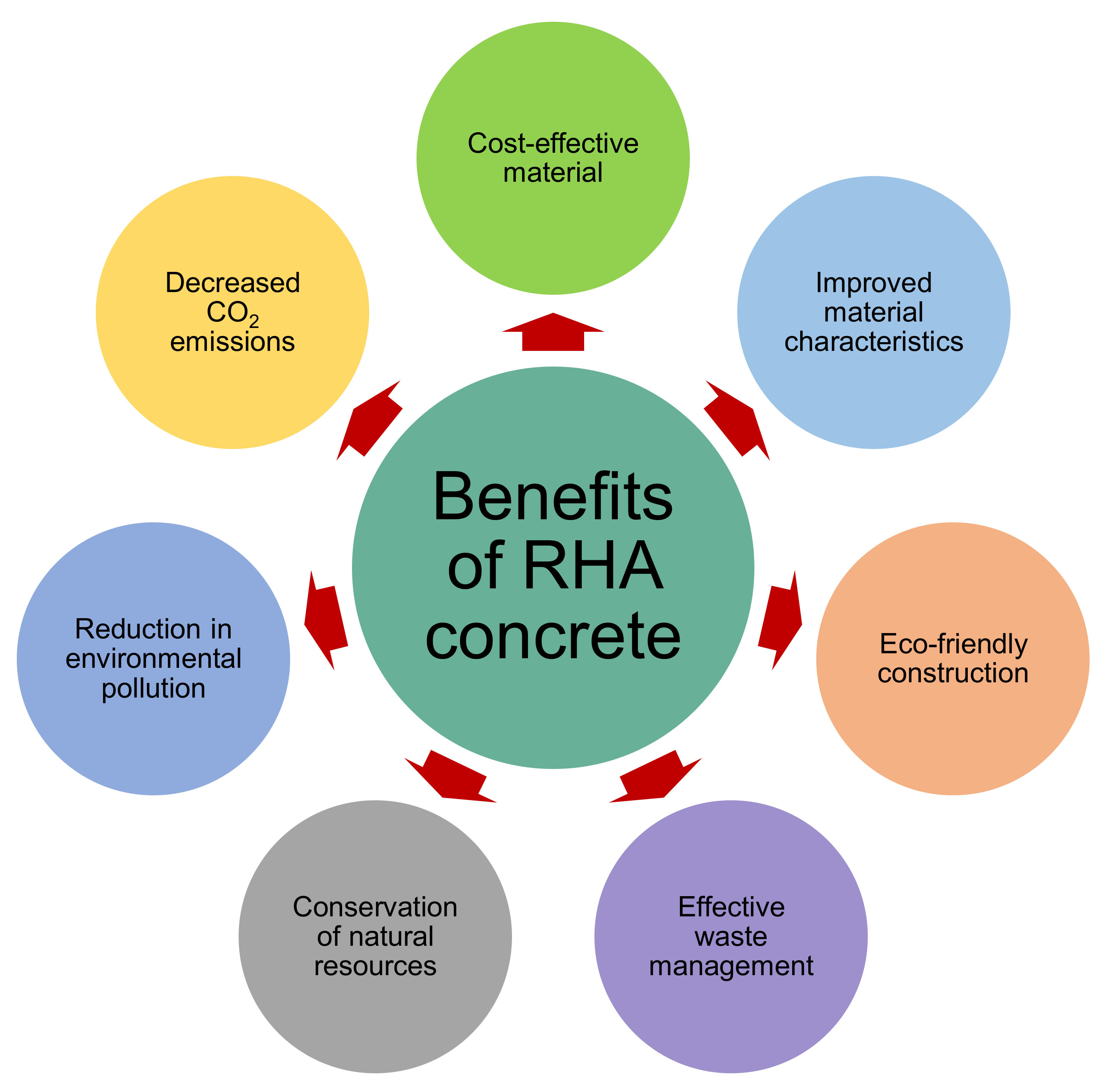
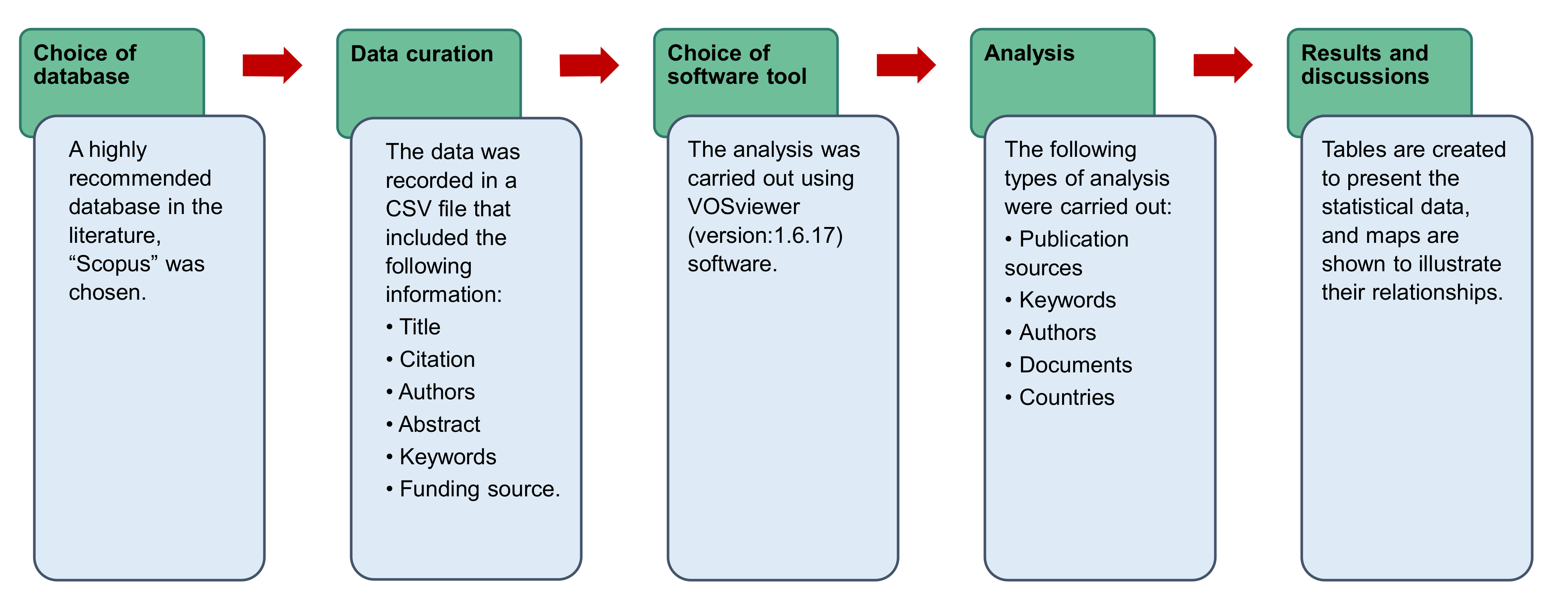

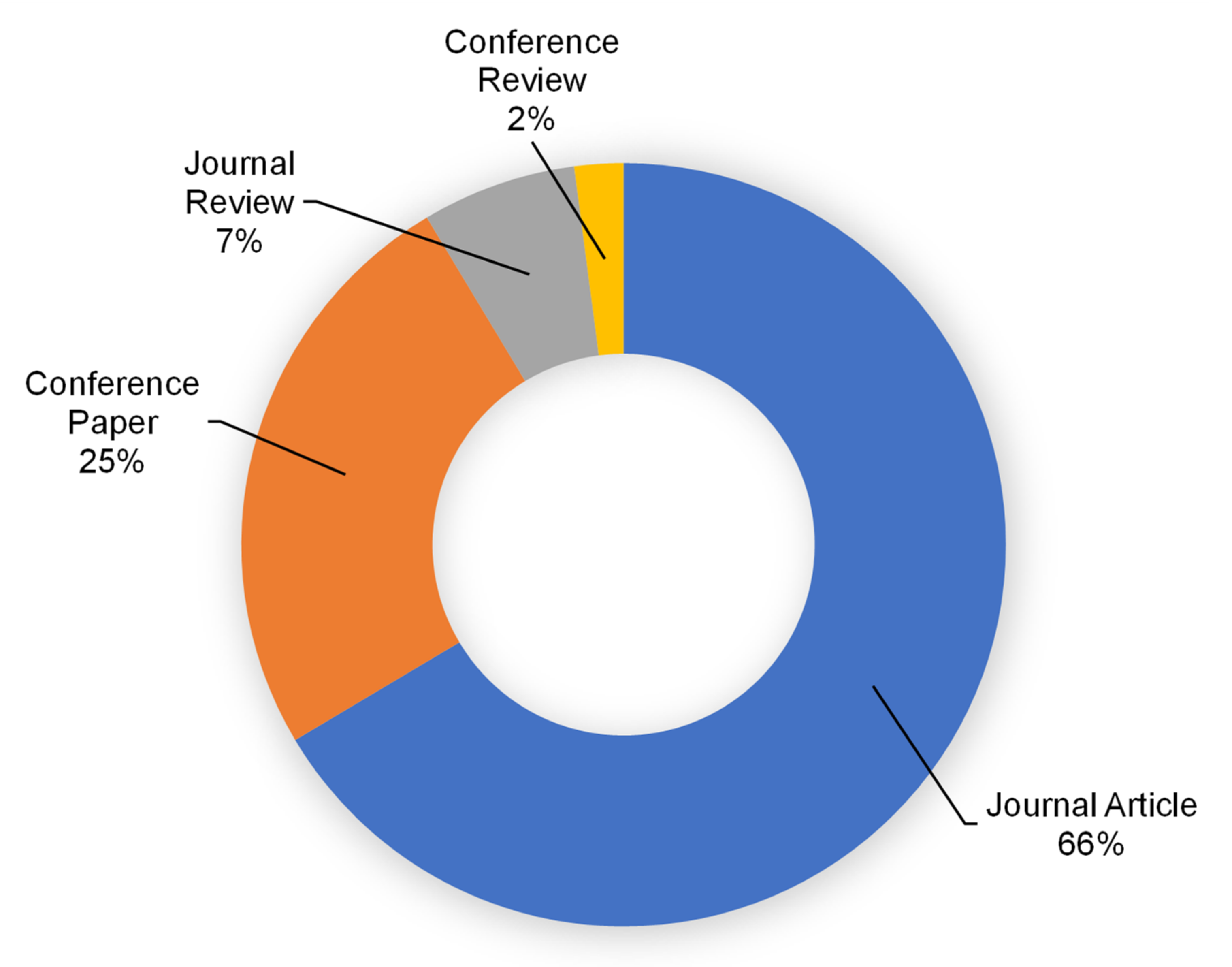
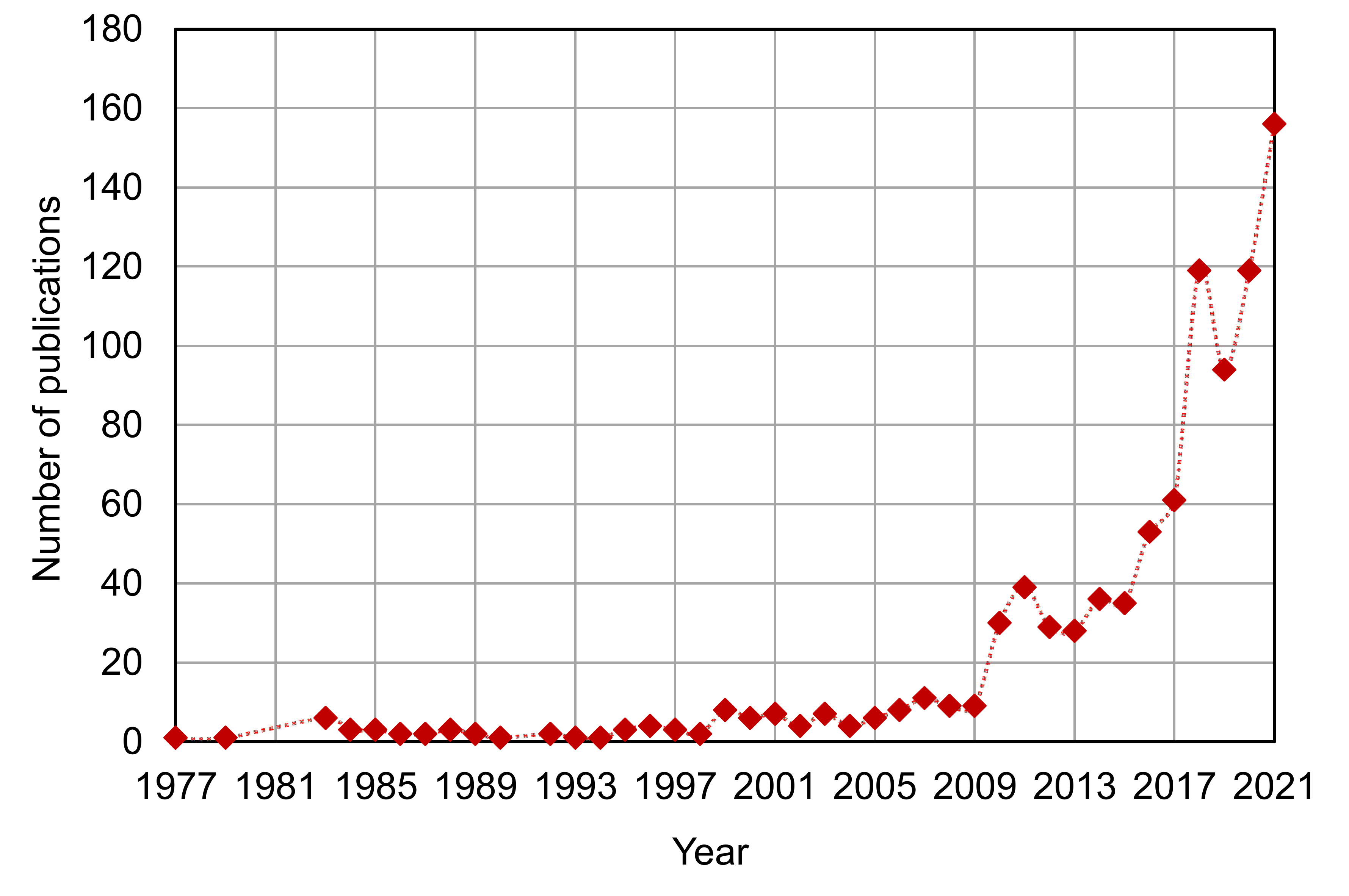
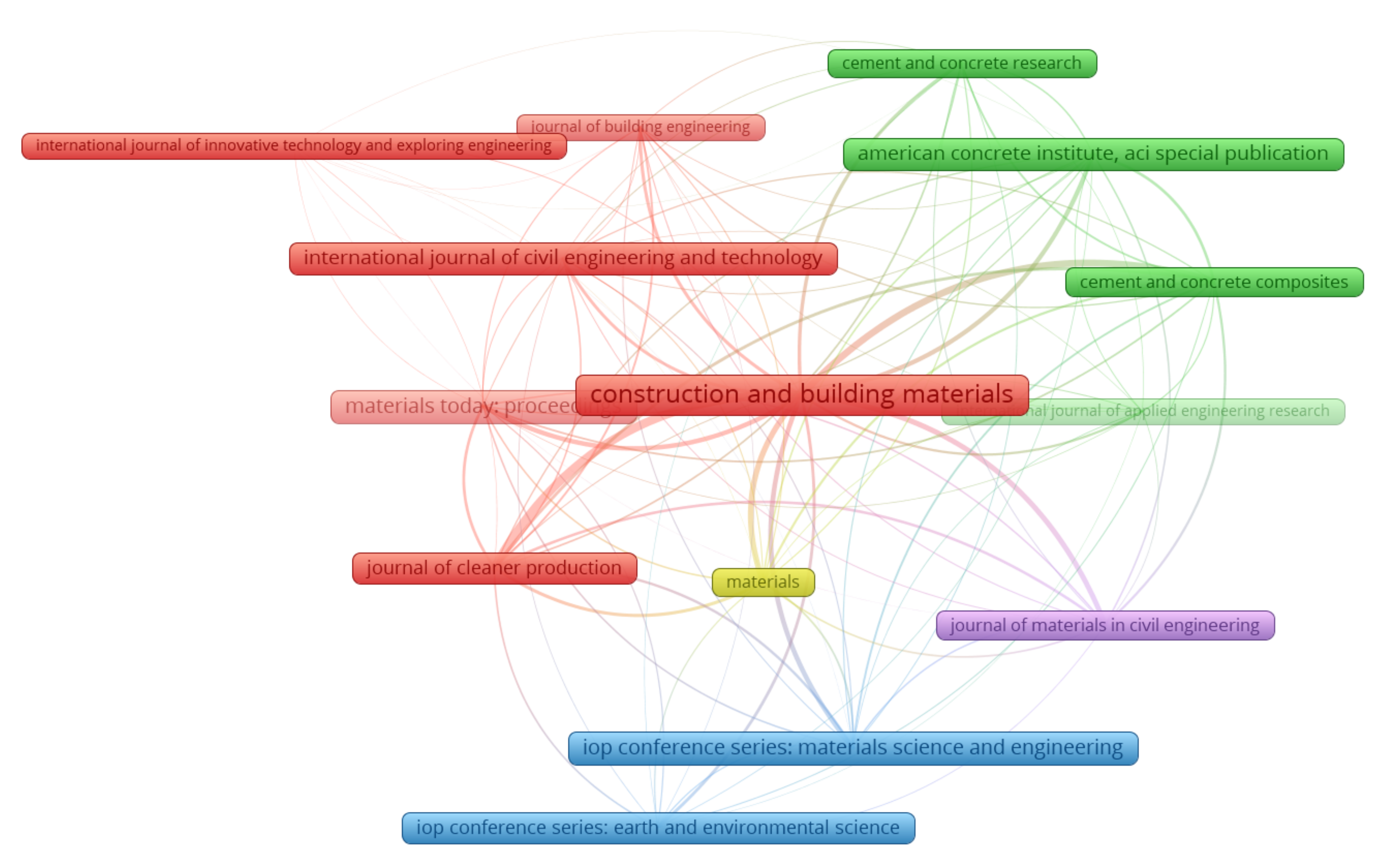
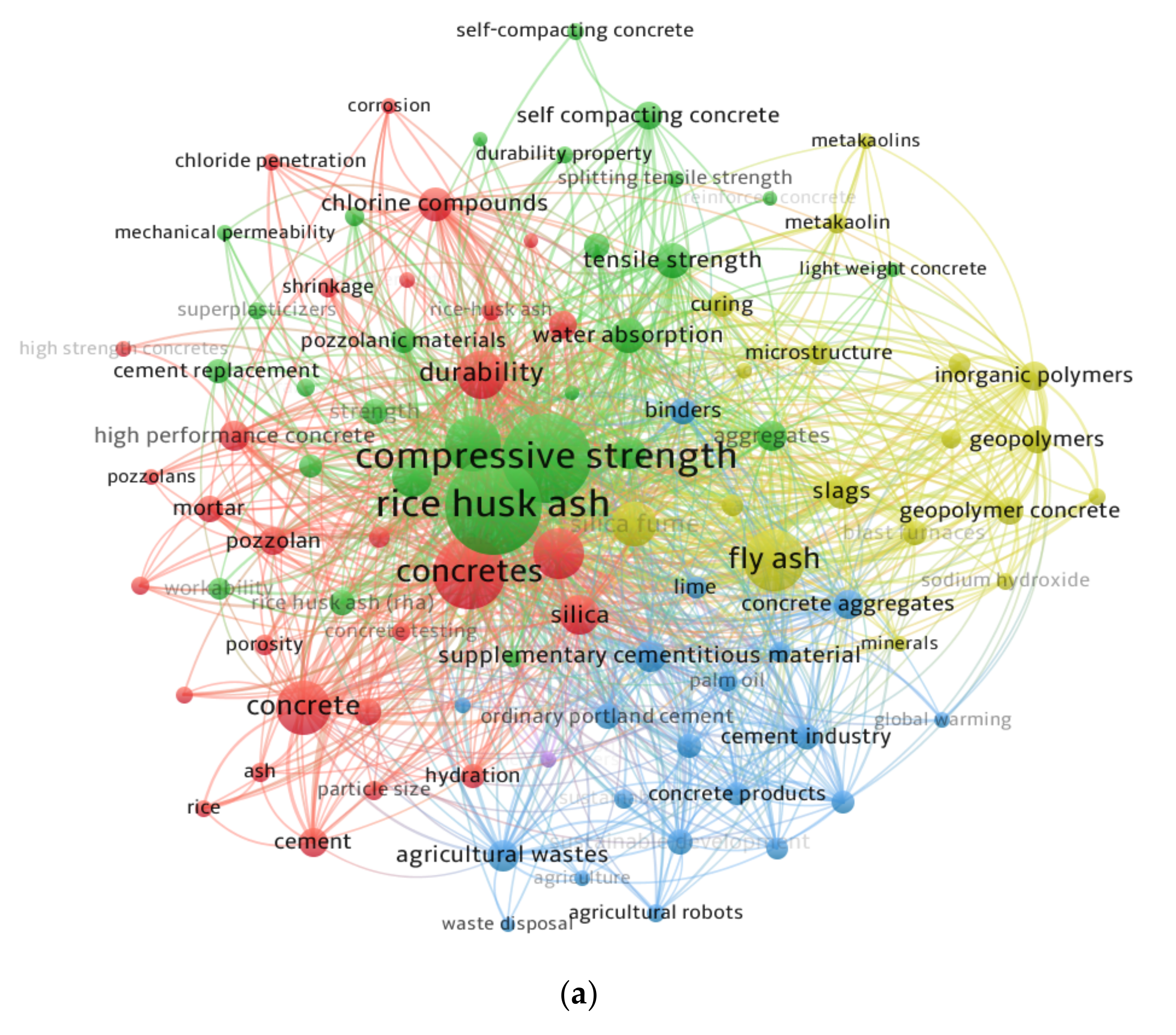
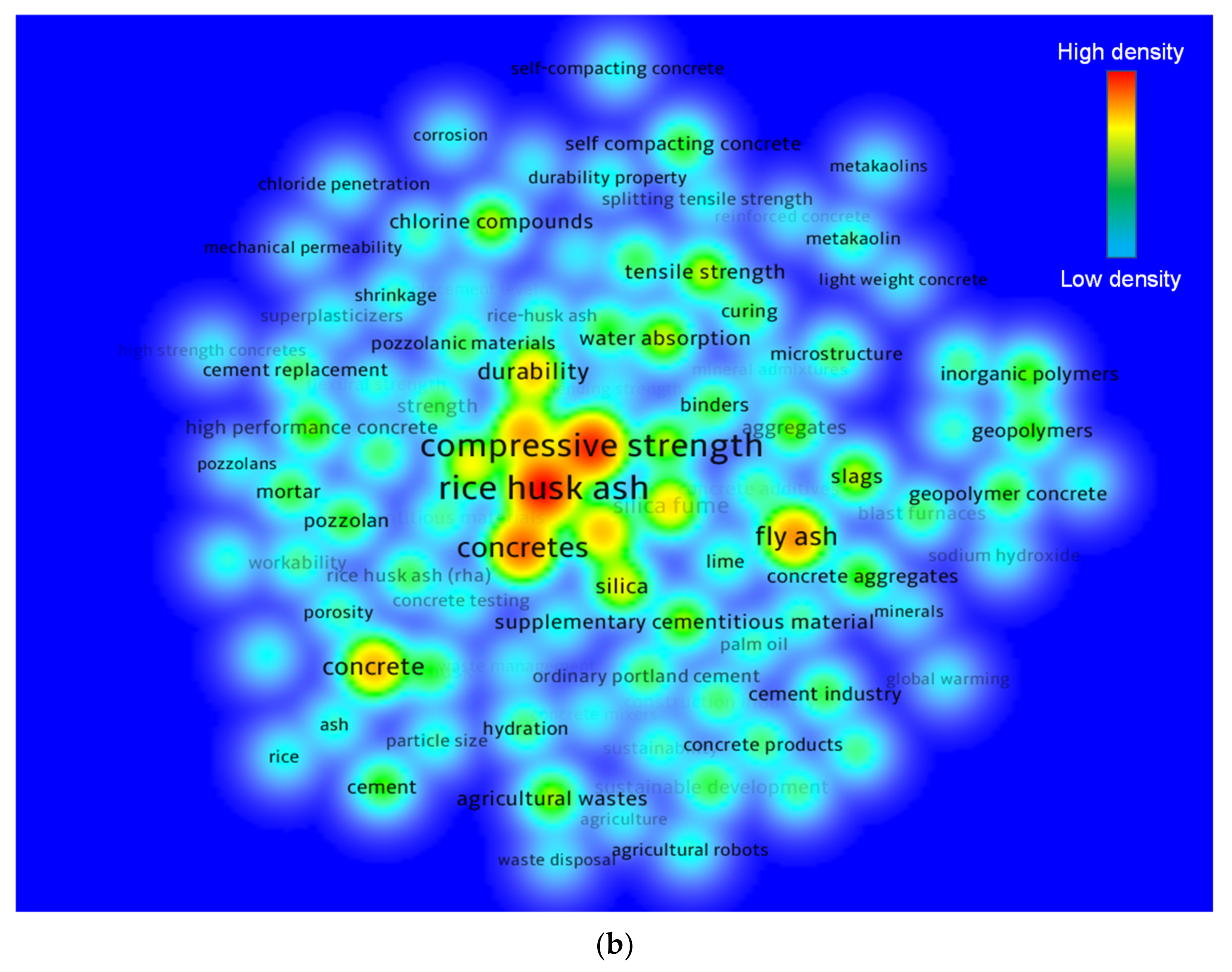
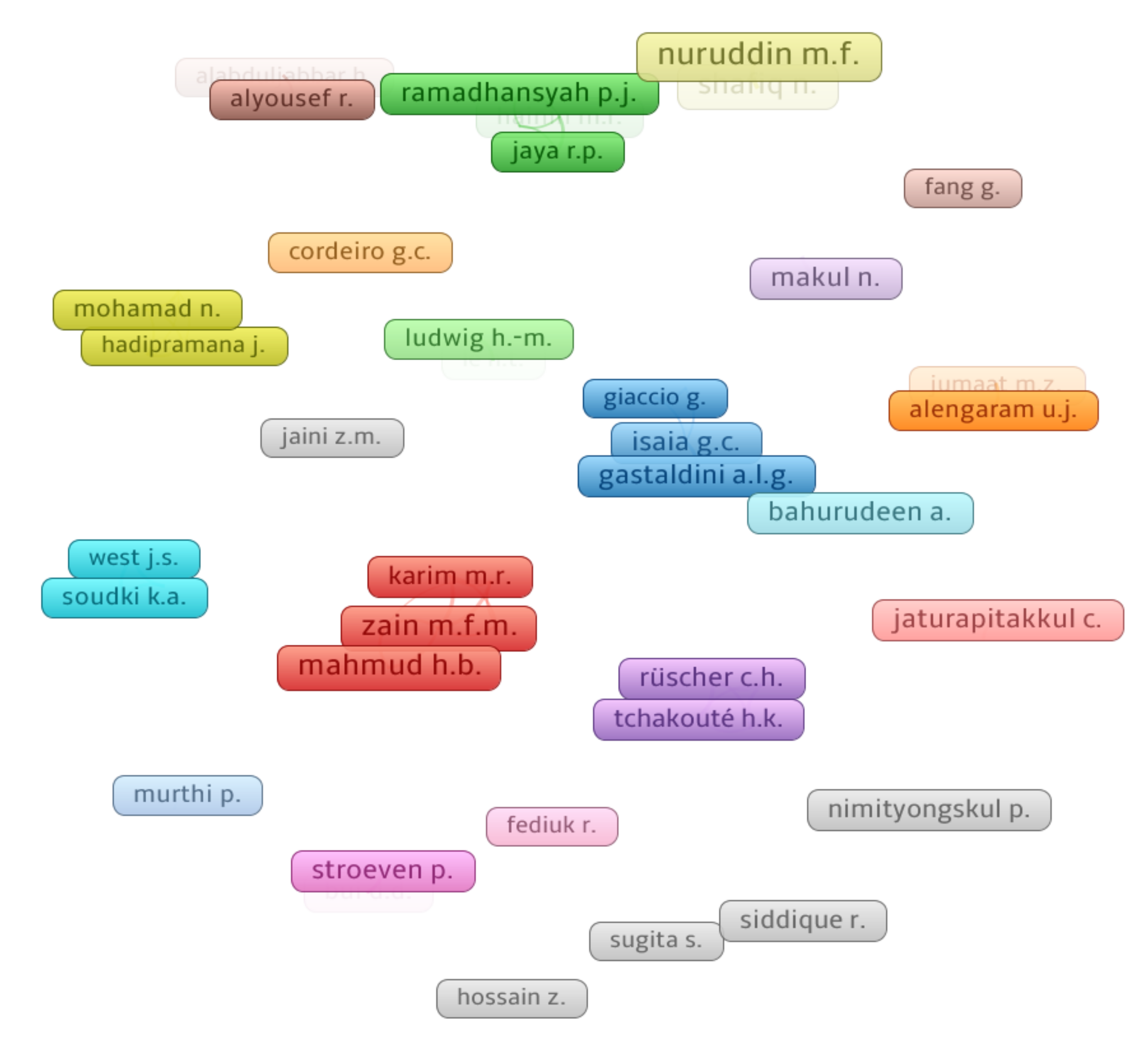
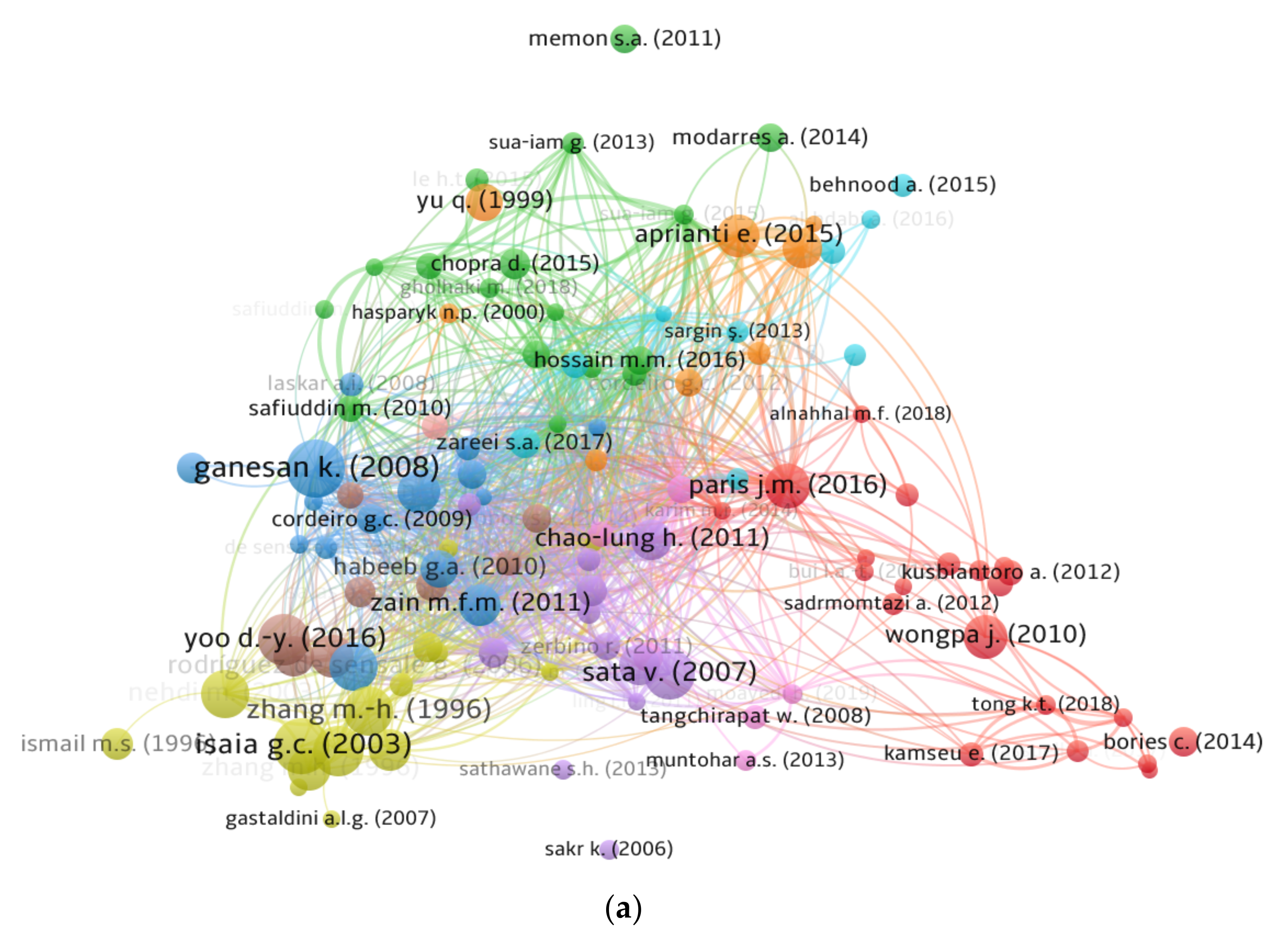
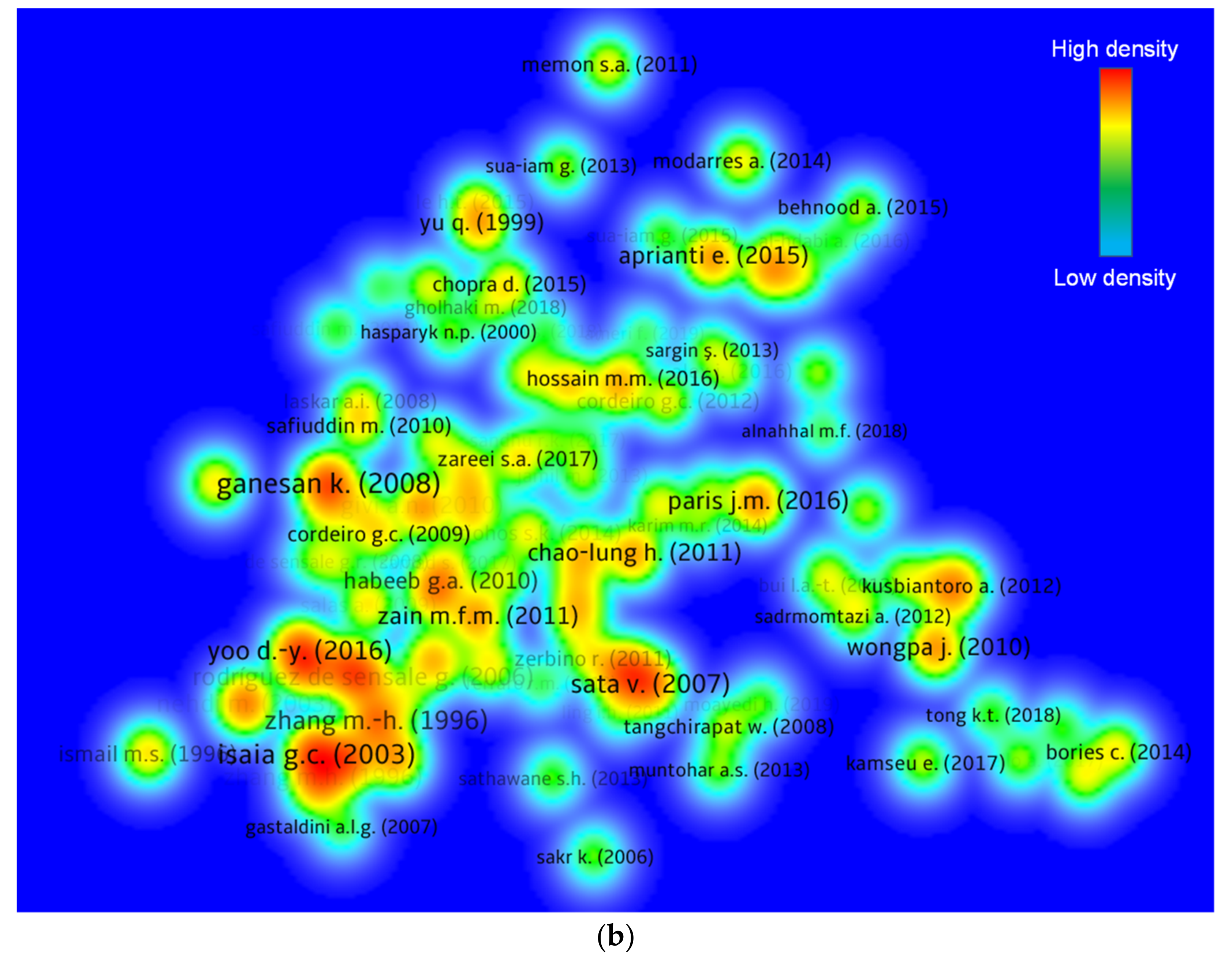
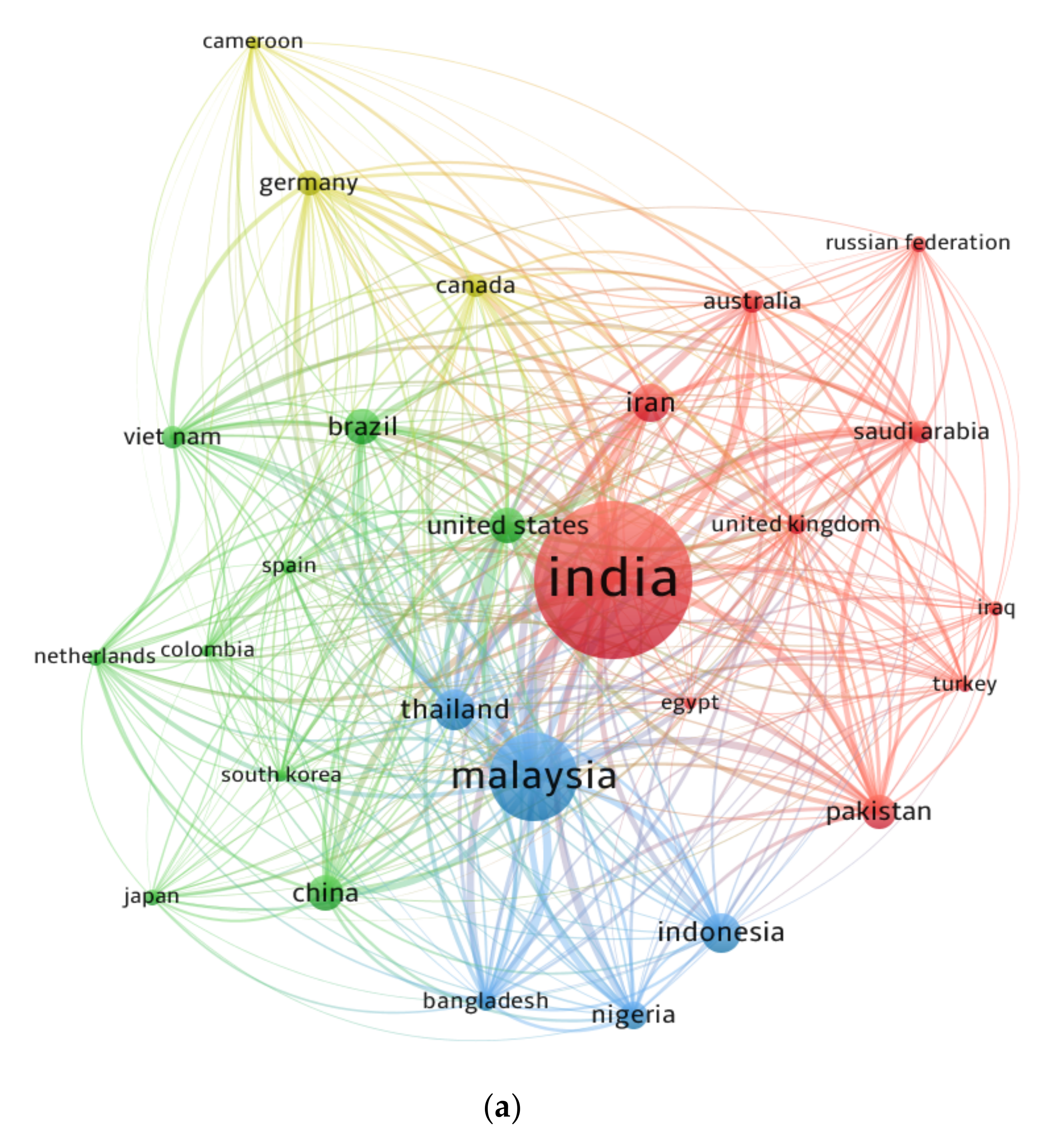
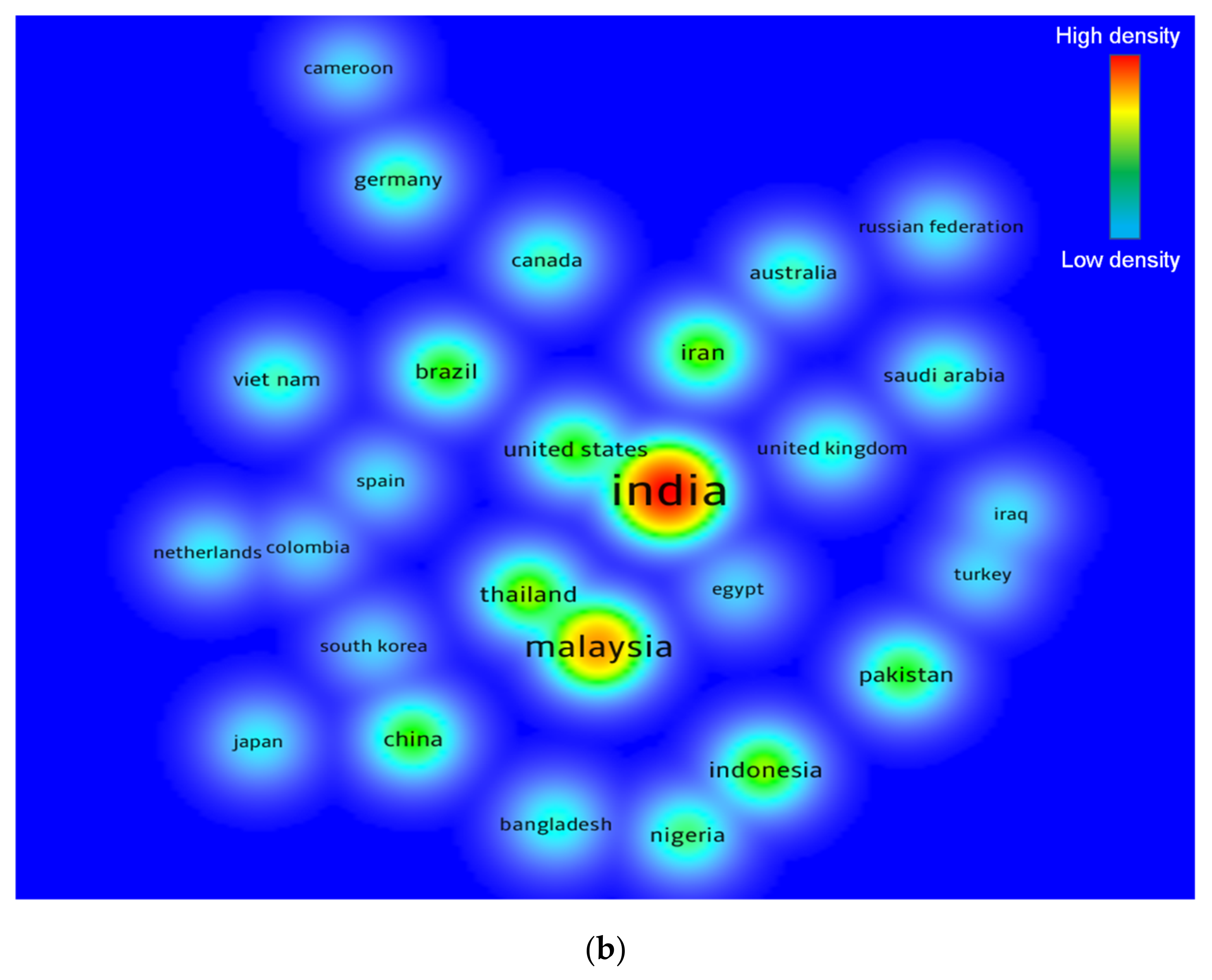
| S/N | Publication Source | Number of Publications | Total Number of Citations |
|---|---|---|---|
| 1 | Construction and building materials | 110 | 6797 |
| 2 | IOP conference series: materials science and engineering | 48 | 110 |
| 3 | Materials today: proceedings | 45 | 227 |
| 4 | American concrete institute, ACI special publication | 35 | 261 |
| 5 | International journal of civil engineering and technology | 32 | 54 |
| 6 | IOP conference series: earth and environmental science | 28 | 22 |
| 7 | Journal of cleaner production | 27 | 1579 |
| 8 | Cement and concrete composites | 21 | 2268 |
| 9 | Journal of materials in civil engineering | 17 | 424 |
| 10 | Cement and concrete research | 14 | 1539 |
| 11 | materials | 13 | 215 |
| 12 | Journal of building engineering | 10 | 144 |
| 13 | International journal of applied engineering research | 10 | 96 |
| 14 | International journal of innovative technology and exploring engineering | 10 | 10 |
| S/N | Keyword | Occurrences |
|---|---|---|
| 1 | Rice husk ash | 460 |
| 2 | Compressive strength | 402 |
| 3 | Concretes | 284 |
| 4 | Fly ash | 214 |
| 5 | Cements | 185 |
| 6 | Concrete | 173 |
| 7 | Portland cement | 154 |
| 8 | Durability | 146 |
| 9 | Silica fume | 126 |
| 10 | Mechanical properties | 106 |
| 11 | Silica | 103 |
| 12 | Tensile strength | 83 |
| 13 | Water absorption | 83 |
| 14 | Slags | 81 |
| 15 | Chlorine compounds | 78 |
| 16 | Concrete mixtures | 75 |
| 17 | Agricultural wastes | 72 |
| 18 | Supplementary cementitious material | 70 |
| 19 | Aggregates | 66 |
| 20 | High performance concrete | 64 |
| S/N | Author | Number of Publications | Total Number of Citations | Average Citations |
|---|---|---|---|---|
| 1 | Nuruddin M.F. | 16 | 309 | 19 |
| 2 | Zain M.F.M. | 14 | 738 | 53 |
| 3 | Mahmud H.B. | 14 | 397 | 28 |
| 4 | Shafiq N. | 13 | 260 | 20 |
| 5 | Jaturapitakkul C. | 10 | 973 | 97 |
| 6 | Makul N. | 10 | 335 | 34 |
| 7 | Isaia G.C. | 9 | 635 | 71 |
| 8 | Gastaldini A.L.G. | 9 | 581 | 65 |
| 9 | Stroeven P. | 9 | 357 | 40 |
| 10 | Rüscher C.H. | 9 | 196 | 22 |
| 11 | Ramadhansyah P.J. | 9 | 90 | 10 |
| 12 | Bahurudeen A. | 9 | 56 | 6 |
| 13 | Chindaprasirt P. | 8 | 668 | 84 |
| 14 | Siddique R. | 8 | 487 | 61 |
| 15 | Karim M.R. | 8 | 380 | 48 |
| 16 | Sua-Iam G. | 8 | 334 | 42 |
| 17 | Tchakouté H.K. | 8 | 189 | 24 |
| 18 | Nimityongskul P. | 8 | 59 | 7 |
| 19 | Jamil M. | 7 | 441 | 63 |
| 20 | Alengaram U.J. | 7 | 222 | 32 |
| 21 | Hainin M.R. | 7 | 44 | 6 |
| 22 | Mohamad N. | 7 | 31 | 4 |
| 23 | Bui D.D. | 6 | 492 | 82 |
| 24 | Ludwig H.-M. | 6 | 437 | 73 |
| 25 | Cordeiro G.C. | 6 | 290 | 48 |
| 26 | Soudki K.A. | 6 | 248 | 41 |
| 27 | Kamseu E. | 6 | 214 | 36 |
| 28 | Leonelli C. | 6 | 214 | 36 |
| 29 | Raman S.N. | 6 | 213 | 36 |
| 30 | Alyousef R. | 6 | 73 | 12 |
| 31 | Jaya R.P. | 6 | 68 | 11 |
| 32 | Murthi P. | 6 | 24 | 4 |
| 33 | Islam M.N. | 5 | 327 | 65 |
| 34 | Le H.T. | 5 | 308 | 62 |
| 35 | Safiuddin M. | 5 | 247 | 49 |
| 36 | West J.S. | 5 | 247 | 49 |
| 37 | Giaccio G. | 5 | 229 | 46 |
| 38 | Zerbino R. | 5 | 229 | 46 |
| 39 | Sugita S. | 5 | 209 | 42 |
| 40 | Jumaat M.Z. | 5 | 167 | 33 |
| 41 | Gobinath R. | 5 | 64 | 13 |
| 42 | Wan Ibrahim M.H. | 5 | 60 | 12 |
| 43 | Alabduljabbar H. | 5 | 40 | 8 |
| 44 | Fediuk R. | 5 | 39 | 8 |
| 45 | Hossain Z. | 5 | 39 | 8 |
| 46 | Samad A.A.A. | 5 | 28 | 6 |
| 47 | Jaini Z.M. | 5 | 22 | 4 |
| 48 | Hadipramana J. | 5 | 10 | 2 |
| 49 | Riza F.V. | 5 | 10 | 2 |
| 50 | Fang G. | 5 | 0 | 0 |
| S/N | Article | Title | Total Number of Citations Received |
|---|---|---|---|
| 1 | Ganesan K. [105] | Rice husk ash blended cement: Assessment of optimal level of replacement for strength and permeability properties of concrete | 346 |
| 2 | Isaia G.C. [106] | Physical and pozzolanic action of mineral additions on the mechanical strength of high-performance concrete | 329 |
| 3 | Yoo D.-Y. [107] | Mechanical properties of ultra-high-performance fiber-reinforced concrete: A review | 288 |
| 4 | Bui D.D. [108] | Particle size effect on the strength of rice husk ash blended gap-graded Portland cement concrete | 283 |
| 5 | Sata V. [109] | Influence of pozzolan from various by-product materials on mechanical properties of high-strength concrete | 278 |
| 6 | Zhang M.-H. [110] | High-performance concrete incorporating rice husk ash as a supplementary cementing material | 271 |
| 7 | Rodríguez De Sensale G. [53] | Strength development of concrete with rice-husk ash | 261 |
| 8 | Nehdi M. [111] | Performance of rice husk ash produced using a new technology as a mineral admixture in concrete | 257 |
| 9 | Paris J.M. [112] | A review of waste products utilized as supplements to Portland cement in concrete | 232 |
| 10 | Wongpa J. [113] | Compressive strength, modulus of elasticity, and water permeability of inorganic polymer concrete | 223 |
| S/N | Country | Number of Publications | Total Number of Citations |
|---|---|---|---|
| 1 | India | 293 | 3098 |
| 2 | Malaysia | 133 | 3104 |
| 3 | Thailand | 48 | 2049 |
| 4 | Indonesia | 46 | 271 |
| 5 | Iran | 44 | 1528 |
| 6 | Brazil | 39 | 1294 |
| 7 | United States | 39 | 1180 |
| 8 | China | 39 | 818 |
| 9 | Pakistan | 37 | 728 |
| 10 | Nigeria | 28 | 360 |
| 11 | Germany | 25 | 729 |
| 12 | Canada | 22 | 1270 |
| 13 | Vietnam | 21 | 1334 |
| 14 | Australia | 21 | 459 |
| 15 | Saudi Arabia | 21 | 225 |
| 16 | United Kingdom | 19 | 394 |
| 17 | Bangladesh | 18 | 481 |
| 18 | Netherlands | 14 | 834 |
| 19 | Japan | 14 | 450 |
| 20 | Russian Federation | 13 | 186 |
| 21 | Iraq | 12 | 225 |
| 22 | Spain | 12 | 153 |
| 23 | Turkey | 11 | 358 |
| 24 | Cameroon | 11 | 295 |
| 25 | South Korea | 10 | 736 |
| 26 | Egypt | 10 | 240 |
| 27 | Colombia | 10 | 223 |
Publisher’s Note: MDPI stays neutral with regard to jurisdictional claims in published maps and institutional affiliations. |
© 2022 by the authors. Licensee MDPI, Basel, Switzerland. This article is an open access article distributed under the terms and conditions of the Creative Commons Attribution (CC BY) license (https://creativecommons.org/licenses/by/4.0/).
Share and Cite
Amin, M.N.; Ahmad, W.; Khan, K.; Sayed, M.M. Mapping Research Knowledge on Rice Husk Ash Application in Concrete: A Scientometric Review. Materials 2022, 15, 3431. https://doi.org/10.3390/ma15103431
Amin MN, Ahmad W, Khan K, Sayed MM. Mapping Research Knowledge on Rice Husk Ash Application in Concrete: A Scientometric Review. Materials. 2022; 15(10):3431. https://doi.org/10.3390/ma15103431
Chicago/Turabian StyleAmin, Muhammad Nasir, Waqas Ahmad, Kaffayatullah Khan, and Mohamed Mahmoud Sayed. 2022. "Mapping Research Knowledge on Rice Husk Ash Application in Concrete: A Scientometric Review" Materials 15, no. 10: 3431. https://doi.org/10.3390/ma15103431
APA StyleAmin, M. N., Ahmad, W., Khan, K., & Sayed, M. M. (2022). Mapping Research Knowledge on Rice Husk Ash Application in Concrete: A Scientometric Review. Materials, 15(10), 3431. https://doi.org/10.3390/ma15103431






